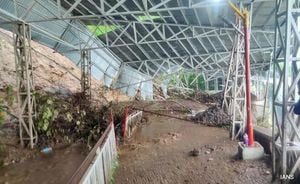On a warm August weekend, Ryan Wardwell, a 46-year-old outdoor enthusiast from Long Beach, California, set out for what he hoped would be a challenging but rewarding adventure: rappelling down the famed Seven Teacups waterfalls in Tulare County. The Seven Teacups, a series of stunning cascades carved into the rugged landscape of the Sequoia National Forest, is well-known among thrill-seekers for its beauty—and its danger. But Wardwell’s outing would soon turn into a harrowing test of survival, one that would grip his family, local authorities, and the wider community for nearly two days.
According to NBC Los Angeles, Wardwell began his descent on Sunday, August 10, 2025, planning to navigate the waterfalls’ notorious drops and swirling pools. The Seven Teacups, which sits about two hours south of Sequoia National Park, draws experienced climbers and canyoneers year-round. Guidebooks and online forums warn that the terrain is unforgiving, demanding not only technical skill but the utmost respect for the river’s unpredictable force. Even so, what happened next was something no amount of preparation could have fully prevented.
As Wardwell rappelled down the falls, the river’s hydraulics—powerful, churning currents created by the cascade—suddenly forced him off his climbing lines. In an instant, he found himself swept behind the waterfall, trapped in a cave-like pocket with no way out. The relentless noise of the water, the spray, and the isolation must have been overwhelming. As Fox News reported, Wardwell was alone, soaked, and cut off from any path to safety.
When Wardwell failed to return to his car that evening, his family quickly grew concerned. By Monday morning, August 11, they had reported him missing, prompting the Tulare County Sheriff’s Office (TCSO) to launch a search. The urgency was clear: the Seven Teacups, while breathtaking, has a reputation for peril. Just last year, three people drowned in a notorious whirlpool in the same area, ominously nicknamed the "toilet bowl."
The search effort was anything but straightforward. As detailed by CBS News Los Angeles, rescue teams faced a daunting combination of steep cliffs, swirling water, and the fast-approaching night. The TCSO deployed specialized cameras and infrared technology on aircraft in hopes of spotting any sign of the missing climber. However, the rough terrain and darkness forced rescuers to postpone their efforts until daylight. The Search and Rescue Teams, including the Swiftwater-Dive Rescue Team, were ready to act but had to wait for conditions to improve.
Early Tuesday morning, August 12, the operation resumed with renewed determination. A dive and rescue team, equipped with a drone, began scouring the area behind the waterfalls. The breakthrough came when the drone’s camera picked up movement behind one of the cascades. There, alive and responsive, was Wardwell—hidden away from view, but very much in need of help.
“He had come off his rappel lines and got trapped behind the waterfall because of the extreme hydraulics of the river,” the Tulare County Sheriff’s Office explained in a statement cited by Fox News. The discovery set off a rapid response. The TCSO coordinated with the California Highway Patrol (CHP), which dispatched a helicopter to the scene. In a dramatic rescue captured on video and shared by police, a member of the rescue team was lowered by hoist into the spray of the falls. Navigating the torrent, the rescuer clipped Wardwell into a harness, and together they were hoisted up to safety.
Wardwell’s ordeal had lasted nearly 48 hours. He emerged from his watery prison suffering only minor injuries and dehydration—an outcome that many, including law enforcement, considered miraculous given the circumstances. Paramedics treated him on site before he was reunited with his relieved family. “Given the dangers of this area, we are fortunate this search ended with a rescue and not a recovery,” Sheriff Mike Boudreaux said, according to CBS News.
The Seven Teacups has long held a dual reputation: its beauty draws adventurers from across the country, but its dangers are well documented. The cascades, formed by Dry Meadow Creek as it tumbles toward the North Fork of the Kern River, create a series of pools and drops that are as treacherous as they are picturesque. Guide sites caution visitors not to attempt the descent without proper gear and extensive experience. Even then, the river’s hydraulics can turn an ordinary rappel into a life-threatening situation in seconds.
Wardwell’s story is a stark reminder of the unpredictability of nature and the importance of preparation and caution. The TCSO Emergency Services Division took the opportunity to remind the public: “Always be aware of your environment and capabilities, especially when navigating whitewater rivers.” The message, issued in an official release on August 13, underscored the point that even seasoned adventurers can find themselves in peril when the elements turn against them.
While Wardwell has not yet spoken publicly about his ordeal, friends and family have expressed immense relief and gratitude for the efforts of the rescuers. The operation’s success was due in large part to the coordination between local authorities, the deployment of advanced technology like drones and infrared cameras, and the expertise of specialized rescue teams. The CHP helicopter crew, in particular, was praised for their precision and bravery during the high-stakes extraction.
This incident also comes on the heels of another rescue in the region: earlier in August, a hiker was saved after falling about 25 feet onto rocks at Big Falls in the San Bernardino Mountains. Such events highlight both the allure and the risk of California’s wild places, where adventure and danger often go hand in hand.
For now, the story of Ryan Wardwell stands as a testament to human resilience, the power of family and community, and the dedication of first responders who risk their own safety to save others. In the end, what could have been a tragedy became a tale of survival and hope in one of California’s wildest beauty spots.




